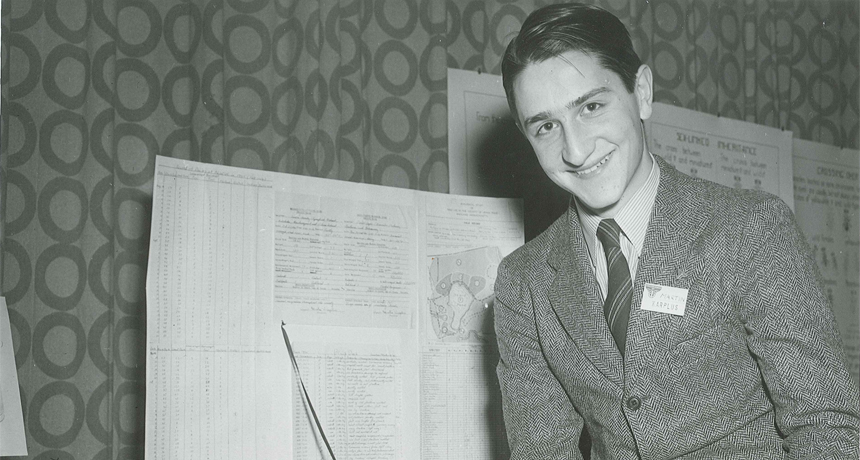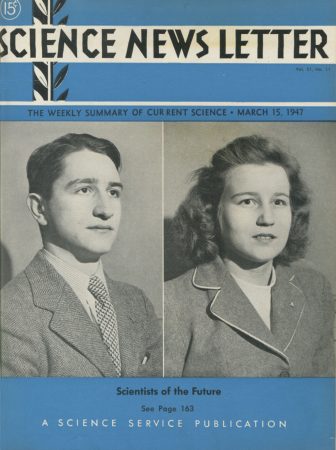From high school prize to Nobel Prize
One of this year’s winners also placed first in the Science Talent Search — a competition for high school students. And he’s not the only STS winner to achieve great things in science.

Martin Karplus sits with his winning project on alcid migration during the 1947 Science Talent Search competition.
Courtesy of SSP
An early start in science can take you a long way!
Last week was Nobel week. It’s the time every year when the Royal Swedish Academy of Sciences in Stockholm announces the year’s Nobel Prizes. A Swedish chemist, Alfred Nobel invented dynamite. But he did not want to be remembered solely as the man who invented a deadly explosive. So in 1901 he established a set of awards to honor people who have made the world a better place through advances in science and in culture.
The Nobel committee informs each year’s winners by phone. And because the morning calls go out from Sweden, their great news may wake up many winners — especially those in the Western Hemisphere. But a little lost sleep is a small price to pay.
This year, Martin Karplus of Harvard University shared the Nobel Prize in chemistry. He helped develop a better understanding of how proteins fold and wiggle. Like the two other scientists who shared this year’s Nobel in chemistry, his work provided information that allowed computers to model how molecules interact. These models changed the world of chemistry, allowing us to accurately picture how chemicals move and merge and change — all on a scale that is far too small to see (at least with the unaided eye).
But before Karplus got his interest in chemistry, he threw it all to the birds. Back in high school, Karplus was particularly interested in alcids. This suborder of birds includes puffins and auks. In 1947, he turned this interest into a project so that he could enter the Science Talent Search. (The Society for Science & the Public, or SSP, created this national contest and still runs it.)

He studied many birds near his home, in New England, and on a trip to eastern Canada. Young Martin’s project must have impressed the STS judges as he shared first place. The award also got him featured on the cover of Science News magazine (published by SSP). The teen went on to conduct studies on birds from Maryland to Alaska before heading to college at Harvard. Only then did his chemistry career begin.
In a recent article about his life, “Spinach on the Ceiling,” Karplus describes his thrill at becoming a finalist in the Science Talent Search. Astronomer Harlow Shapley, the chief judge, “charmed me with his apparent interest in my project,” he recalls. And winning first place “made up for the discouraging interactions with some of my high school teachers.” Especially memorable: He noted that “we met President Truman, who welcomed us as the future leaders of America.”
Karplus is not the only former science fair winner to go on to great things in science. In fact, seven other Science Talent Search finalists have won Nobel Prizes! They include another 1947 finalist, Leon Cooper. He entered with a project that made bacteria resistant to penicillin. This finalist went on to acquire a 1972 Nobel Prize in physics.
Now director of Brown University’s Center for Neural Science, Cooper’s research over the decades has taken him from biology to physics to neuroscience! In high school, “I was interested in biology and in physics,” Cooper recalls. So when he went to college, “I decided to major in physics; if I didn’t do it I’d never learn it.” And today, he says, “I’m very, very happy I did.”
Cooper says that taking part in the national high-school competition helped him on that path. “[Being a finalist in] the Science Talent Search got me into Columbia [University],” he said, and that brought “an enormous change in my life.”
The other Science Talent Search alumni that have gone on to win the Nobel Prize: Ben Mottelson (for physics in 1975), Walter Gilbert (for chemistry in 1980), Sheldon Glashow (for physics in 1979), Roald Hoffman (for chemistry in 1981), Frank Wilczek (for physics in 2004) and Roger Tsien (for chemistry in 2008). Wilczek, a mathematician and physicist now works at the Massachusetts Institute of Technology. He also serves on the board of SSP.
It just goes to show how pursuing an interest in science early can be the first step toward big things later on.
Power Words:
alcid A suborder of birds that includes puffins and auks
auk A small black and white seabird with a tiny beak
chemistry A science that deals with the composition, structure and properties of substances and with the changes that they go through. Chemists use this knowledge to study unfamiliar substances, to reproduce large quantities of useful substances, or to design and create new and useful substances
dynamite An explosive made of nitroglycerin soaked material that blows up when ignited
economics The study of how goods are made, traded, and used
molecule An electrically neutral group of atoms that represents the smallest possible amount of a chemical compound. Molecules can be made of single types of atoms or of different types. For example, the oxygen in the air is made of two oxygen atoms (O2), but water is made of two hydrogen atoms and one oxygen atom (H2O)
Nobel Prizes Awards that recognize cultural and scientific advances that have changed the world in each of several fields. Among the sciences, these annual awards go out to up to three individuals in three areas: physics, chemistry and physiology or medicine. To be eligible, a candidate must be living
neuroscience Studies of the structure or function of the brain and other parts of the nervous system. Researchers in this field are known as neuroscientists
physics The scientific study of the nature and properties of matter and energy
physiology The branch of biology that deals with the everyday functions of living organisms and how their parts function
puffin A seabird that is black and white, with a brightly colored beak
superconductors Materials that can keep an electric current going without a power source, which usually requires keeping the material extremely cold